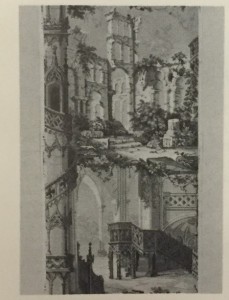The ornate pulpit of a ruined monastery forms the focus of this Gothic revival sidewall. The scene is bordered on either side by a large pillar with what could be a spiral staircase wrapped around it. Done in subdued monochrome, the detailing of the pulpit is beautifully done as is the gradation of color in the foliage in foreground. Stylistically, this paper has much in common with papers seen in the mid-nineteenth century. In fact, there is at least one paper from France with a very similar design that was produced in the late 1840s, suggesting this paper was partially copied from the earlier example.

The popularity of illusionistic wallpapers in the mid-nineteenth century was connected to the rise of machine-printing. As this paper demonstrates, elaborate visual scenes were easy to print with machines. However, the influential writings of the design reformers AWN Pugin, John Ruskin, and Owen Jones and the development of the Arts and Crafts and Art Nouveau movements led to a widespread rejection of the trompe-l’oeil effect seen in this paper. Thus, the fact that this paper was produced at the dawn of the 20th century is quite surprising, as it would have seemed very old-fashioned by this time if not in bad taste.
The producer of this wallpaper, Thomas Strahan and Co., was an American manufacturer centered in Chelsea, Massachusetts. It was founded in 1885 and specialized in machine printing, producing papers in a wide variety of styles. In fact, this old-fashioned Gothic Revival paper could have been sold beside more modern, Arts and Crafts-style papers which were based on the papers of William Morris. The contrast between the straightforward depiction of Gothic architecture in this paper and the subtler medieval influence in the Morris-inspired papers demonstrates the wildly different ways the obsession with the medieval was expressed in design at this time. This ability to juggle styles contributed to the company’s success. It continues to produce wallpapers today, specializing in reproductions of its historic designs.
Nicholas Lopes is a student in the History of Design and Curatorial Studies graduate program at the Cooper Hewitt, and is a Master’s Fellow in the Wallcoverings Department.
